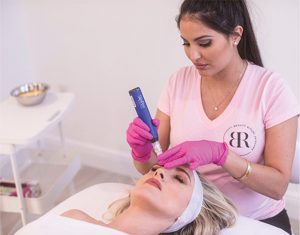 Microneedling is most well-known for its anti-aging benefits popularized by Kim Kardashian’s “Vampire Facial,” but can also be beneficial in managing hyperpigmentation. As a relatively new treatment, microneedling shows promising results for skin rejuvenation as well as correction of hyperpigmentation.
Microneedling is most well-known for its anti-aging benefits popularized by Kim Kardashian’s “Vampire Facial,” but can also be beneficial in managing hyperpigmentation. As a relatively new treatment, microneedling shows promising results for skin rejuvenation as well as correction of hyperpigmentation.
How does microneedling achieve what seems like miraculous results on such a variety of different skin conditions? Microneedling safely penetrates the dermis with minimal, if any, damage to the epidermis. This ability to preserve the epidermis during the treatment is what sets microneedling apart from its counterparts such as chemical peels and lasers. As the needles penetrate through the stratum corneum (the outermost layer of the epidermis), they avoid the bi-layered lipid barrier that is used to protect the dermis and structures below. When these micro-channels are created, not only is the body’s wound healing cascade triggered, but it also creates a pathway to deliver any desired nutrients to the dermis.
In more recent years, microneedling has shown promising results for hyperpigmentation. How does microneedling improve the appearance of hyperpigmentation? It restores keratinocyte and fibroblast function. The cells’ restorative function ultimately normalizes cell signaling between the melanocytes leading to improved pigment uptake.
Proper preparation and after care in the treatment of hyperpigmentation with microneedling is vital to desired effectiveness. Additionally, 2-6 weeks prior to treatment (stopping at least 5 days prior to microneedling procedure) the use of a combination of tyrosinase inhibitors such as hydroquinone, azelaic acid, tranexamic acid and kojic acid to name a few is highly encouraged. The use of retinoids such as retinoic acid or retinol can potentiate results. Incorporating topical antioxidant serums such as vitamin C, vitamin E or ferulic acid will enhance the possibility of optimal results, as well as other topical skincare products such as copper peptides and growth factors. The most important product is daily use of at least SPF 50 sunscreen. Although microchannels usually close between 10-15 minutes post procedure, nightly application of a prescription strength depigmentation cream 24 hours post-procedure should significantly reduce pigmentation. Continued daily SPF 50 or above is vital as well. Subsequent procedures are encouraged for optimal results usually 4-6 weeks apart. After 3 months of using the prescription depigmentation cream, gradually switching to hydroquinone-free tyrosinase inhibitors will minimize or eliminate the potential for adverse side effects such as worsening hyperpigmentation.
While microneedling has many known benefits for skin health, there are a few contraindications with its use. Microneedling should not be done on those with active acne, as it can encourage the spread of Cutibacterium acnes bacteria. Those with any history of herpes infection should avoid microneedling, but if going forward with treatment, practitioner should use caution and prep them properly with an anti-viral medication prior to microneedling treatment. A patient who has any blood clotting disorder, such as thrombocytopenia or is on any blood thinners should avoid microneedling treatments. Those with severe chronic skin
conditions such as eczema and psoriasis are not typically ideal clients for microneedling. Those undergoing chemotherapy or radiation are also not candidates for this procedure. Instead, patients can opt for more conservative treatments and skin care products that gently resurface the skin overtime while avoiding provoking any health complications.
To schedule your appointment, please call (239) 437-4110 today.









